Santiago Zanella-Béguelin
Microsoft Research
Securing AI Agents with Information-Flow Control
May 29, 2025Abstract:As AI agents become increasingly autonomous and capable, ensuring their security against vulnerabilities such as prompt injection becomes critical. This paper explores the use of information-flow control (IFC) to provide security guarantees for AI agents. We present a formal model to reason about the security and expressiveness of agent planners. Using this model, we characterize the class of properties enforceable by dynamic taint-tracking and construct a taxonomy of tasks to evaluate security and utility trade-offs of planner designs. Informed by this exploration, we present Fides, a planner that tracks confidentiality and integrity labels, deterministically enforces security policies, and introduces novel primitives for selectively hiding information. Its evaluation in AgentDojo demonstrates that this approach broadens the range of tasks that can be securely accomplished. A tutorial to walk readers through the the concepts introduced in the paper can be found at https://github.com/microsoft/fides
The Canary's Echo: Auditing Privacy Risks of LLM-Generated Synthetic Text
Feb 19, 2025



Abstract:How much information about training samples can be gleaned from synthetic data generated by Large Language Models (LLMs)? Overlooking the subtleties of information flow in synthetic data generation pipelines can lead to a false sense of privacy. In this paper, we design membership inference attacks (MIAs) that target data used to fine-tune pre-trained LLMs that are then used to synthesize data, particularly when the adversary does not have access to the fine-tuned model but only to the synthetic data. We show that such data-based MIAs do significantly better than a random guess, meaning that synthetic data leaks information about the training data. Further, we find that canaries crafted to maximize vulnerability to model-based MIAs are sub-optimal for privacy auditing when only synthetic data is released. Such out-of-distribution canaries have limited influence on the model's output when prompted to generate useful, in-distribution synthetic data, which drastically reduces their vulnerability. To tackle this problem, we leverage the mechanics of auto-regressive models to design canaries with an in-distribution prefix and a high-perplexity suffix that leave detectable traces in synthetic data. This enhances the power of data-based MIAs and provides a better assessment of the privacy risks of releasing synthetic data generated by LLMs.
Permissive Information-Flow Analysis for Large Language Models
Oct 04, 2024



Abstract:Large Language Models (LLMs) are rapidly becoming commodity components of larger software systems. This poses natural security and privacy problems: poisoned data retrieved from one component can change the model's behavior and compromise the entire system, including coercing the model to spread confidential data to untrusted components. One promising approach is to tackle this problem at the system level via dynamic information flow (aka taint) tracking. Unfortunately, the traditional approach of propagating the most restrictive input label to the output is too conservative for applications where LLMs operate on inputs retrieved from diverse sources. In this paper, we propose a novel, more permissive approach to propagate information flow labels through LLM queries. The key idea behind our approach is to propagate only the labels of the samples that were influential in generating the model output and to eliminate the labels of unnecessary input. We implement and investigate the effectiveness of two variations of this approach, based on (i) prompt-based retrieval augmentation, and (ii) a $k$-nearest-neighbors language model. We compare these with the baseline of an introspection-based influence estimator that directly asks the language model to predict the output label. The results obtained highlight the superiority of our prompt-based label propagator, which improves the label in more than 85% of the cases in an LLM agent setting. These findings underscore the practicality of permissive label propagation for retrieval augmentation.
Closed-Form Bounds for DP-SGD against Record-level Inference
Feb 22, 2024



Abstract:Machine learning models trained with differentially-private (DP) algorithms such as DP-SGD enjoy resilience against a wide range of privacy attacks. Although it is possible to derive bounds for some attacks based solely on an $(\varepsilon,\delta)$-DP guarantee, meaningful bounds require a small enough privacy budget (i.e., injecting a large amount of noise), which results in a large loss in utility. This paper presents a new approach to evaluate the privacy of machine learning models against specific record-level threats, such as membership and attribute inference, without the indirection through DP. We focus on the popular DP-SGD algorithm, and derive simple closed-form bounds. Our proofs model DP-SGD as an information theoretic channel whose inputs are the secrets that an attacker wants to infer (e.g., membership of a data record) and whose outputs are the intermediate model parameters produced by iterative optimization. We obtain bounds for membership inference that match state-of-the-art techniques, whilst being orders of magnitude faster to compute. Additionally, we present a novel data-dependent bound against attribute inference. Our results provide a direct, interpretable, and practical way to evaluate the privacy of trained models against specific inference threats without sacrificing utility.
Rethinking Privacy in Machine Learning Pipelines from an Information Flow Control Perspective
Nov 27, 2023
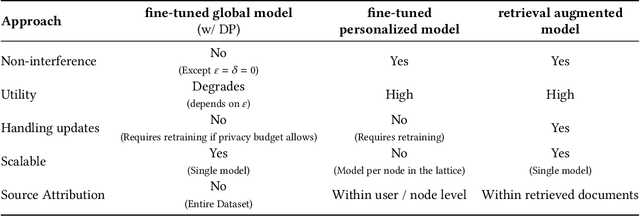
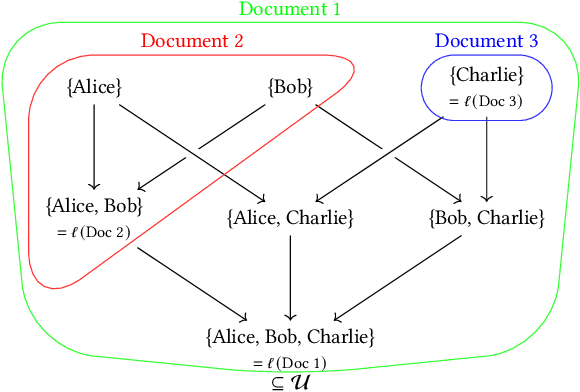

Abstract:Modern machine learning systems use models trained on ever-growing corpora. Typically, metadata such as ownership, access control, or licensing information is ignored during training. Instead, to mitigate privacy risks, we rely on generic techniques such as dataset sanitization and differentially private model training, with inherent privacy/utility trade-offs that hurt model performance. Moreover, these techniques have limitations in scenarios where sensitive information is shared across multiple participants and fine-grained access control is required. By ignoring metadata, we therefore miss an opportunity to better address security, privacy, and confidentiality challenges. In this paper, we take an information flow control perspective to describe machine learning systems, which allows us to leverage metadata such as access control policies and define clear-cut privacy and confidentiality guarantees with interpretable information flows. Under this perspective, we contrast two different approaches to achieve user-level non-interference: 1) fine-tuning per-user models, and 2) retrieval augmented models that access user-specific datasets at inference time. We compare these two approaches to a trivially non-interfering zero-shot baseline using a public model and to a baseline that fine-tunes this model on the whole corpus. We evaluate trained models on two datasets of scientific articles and demonstrate that retrieval augmented architectures deliver the best utility, scalability, and flexibility while satisfying strict non-interference guarantees.
Analyzing Leakage of Personally Identifiable Information in Language Models
Feb 01, 2023



Abstract:Language Models (LMs) have been shown to leak information about training data through sentence-level membership inference and reconstruction attacks. Understanding the risk of LMs leaking Personally Identifiable Information (PII) has received less attention, which can be attributed to the false assumption that dataset curation techniques such as scrubbing are sufficient to prevent PII leakage. Scrubbing techniques reduce but do not prevent the risk of PII leakage: in practice scrubbing is imperfect and must balance the trade-off between minimizing disclosure and preserving the utility of the dataset. On the other hand, it is unclear to which extent algorithmic defenses such as differential privacy, designed to guarantee sentence- or user-level privacy, prevent PII disclosure. In this work, we propose (i) a taxonomy of PII leakage in LMs, (ii) metrics to quantify PII leakage, and (iii) attacks showing that PII leakage is a threat in practice. Our taxonomy provides rigorous game-based definitions for PII leakage via black-box extraction, inference, and reconstruction attacks with only API access to an LM. We empirically evaluate attacks against GPT-2 models fine-tuned on three domains: case law, health care, and e-mails. Our main contributions are (i) novel attacks that can extract up to 10 times more PII sequences as existing attacks, (ii) showing that sentence-level differential privacy reduces the risk of PII disclosure but still leaks about 3% of PII sequences, and (iii) a subtle connection between record-level membership inference and PII reconstruction.
SoK: Let The Privacy Games Begin! A Unified Treatment of Data Inference Privacy in Machine Learning
Dec 21, 2022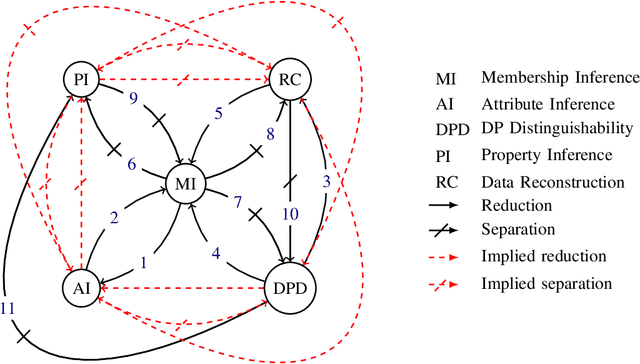
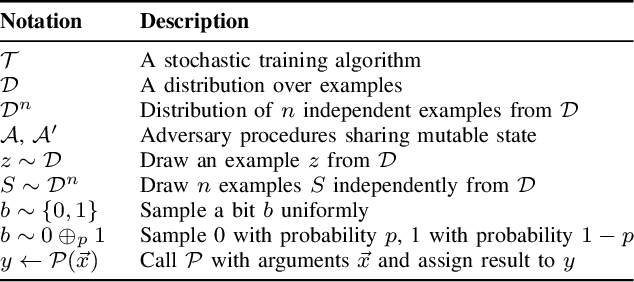

Abstract:Deploying machine learning models in production may allow adversaries to infer sensitive information about training data. There is a vast literature analyzing different types of inference risks, ranging from membership inference to reconstruction attacks. Inspired by the success of games (i.e., probabilistic experiments) to study security properties in cryptography, some authors describe privacy inference risks in machine learning using a similar game-based style. However, adversary capabilities and goals are often stated in subtly different ways from one presentation to the other, which makes it hard to relate and compose results. In this paper, we present a game-based framework to systematize the body of knowledge on privacy inference risks in machine learning.
Bayesian Estimation of Differential Privacy
Jun 15, 2022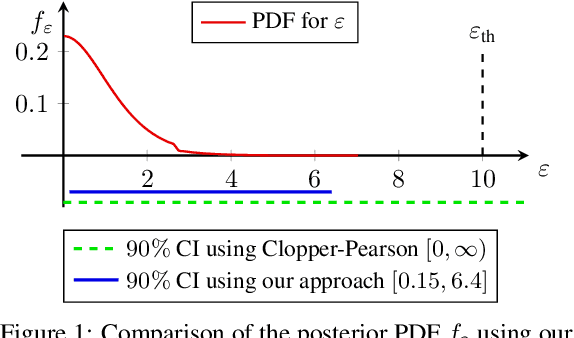
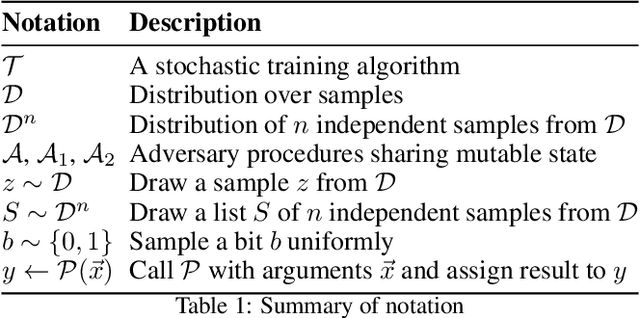
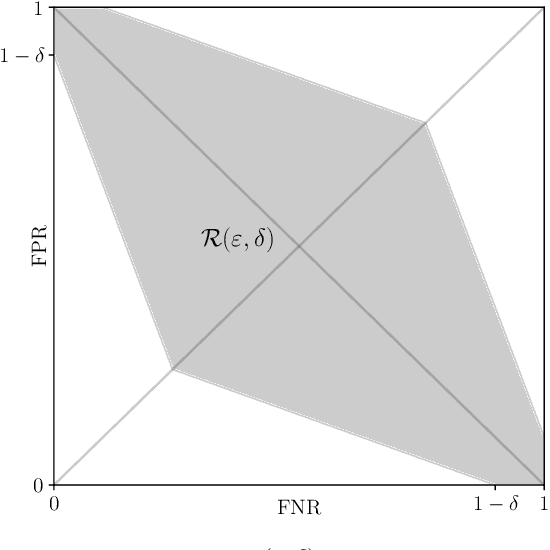
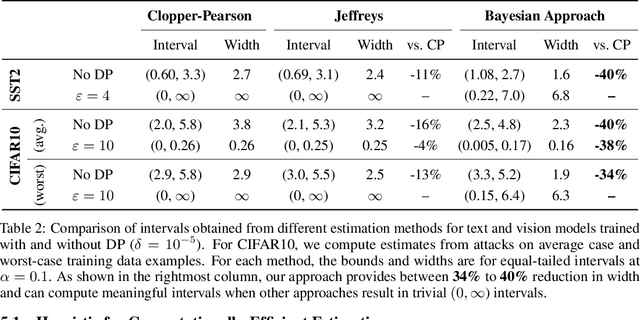
Abstract:Algorithms such as Differentially Private SGD enable training machine learning models with formal privacy guarantees. However, there is a discrepancy between the protection that such algorithms guarantee in theory and the protection they afford in practice. An emerging strand of work empirically estimates the protection afforded by differentially private training as a confidence interval for the privacy budget $\varepsilon$ spent on training a model. Existing approaches derive confidence intervals for $\varepsilon$ from confidence intervals for the false positive and false negative rates of membership inference attacks. Unfortunately, obtaining narrow high-confidence intervals for $\epsilon$ using this method requires an impractically large sample size and training as many models as samples. We propose a novel Bayesian method that greatly reduces sample size, and adapt and validate a heuristic to draw more than one sample per trained model. Our Bayesian method exploits the hypothesis testing interpretation of differential privacy to obtain a posterior for $\varepsilon$ (not just a confidence interval) from the joint posterior of the false positive and false negative rates of membership inference attacks. For the same sample size and confidence, we derive confidence intervals for $\varepsilon$ around 40% narrower than prior work. The heuristic, which we adapt from label-only DP, can be used to further reduce the number of trained models needed to get enough samples by up to 2 orders of magnitude.
Analyzing Privacy Loss in Updates of Natural Language Models
Jan 14, 2020
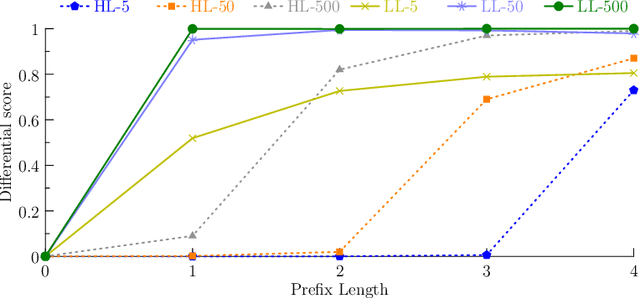


Abstract:To continuously improve quality and reflect changes in data, machine learning-based services have to regularly re-train and update their core models. In the setting of language models, we show that a comparative analysis of model snapshots before and after an update can reveal a surprising amount of detailed information about the changes in the data used for training before and after the update. We discuss the privacy implications of our findings, propose mitigation strategies and evaluate their effect.
 Add to Chrome
Add to Chrome Add to Firefox
Add to Firefox Add to Edge
Add to Edge